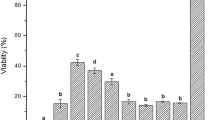Abstract
The survival of four strains of yeast belonging to the speciesSaccharomyces cerevisiae, Candida wickerhamii, Candida boidinii andWilliopsis californica was studied in extra virgin olive oil flavoured with garlic, lemon, oregano and red chilli pepper. The ingredients used in the doses of 1%, 5% and 10% profoundly modified the habitat of the extra virgin olive oil, reducing drastically, in 90 days of storage, the survival of the yeasts by 20–50%, in the following decreasing order: lemon, garlic, oregano and red chilli pepper. Among the yeasts studied,W. californica strain 1639 was found to be one of the most sensitive, whileS. cerevisiae strain 1525 was one of the most tolerant regarding the ingredients present in the flavoured olive oil. The observations carried out with a scanning electron microscope (SEM) highlighted the presence of frequent lesions on the cellular wall ofC. wickerhamii 1532,C. boidinii 1638 andS. cerevisiae 1525 and only in a few rare cases inW. californica 1639. Nevertheless, since the survival ofW. californica 1639 in the flavoured olive oil was compromised to a greater extent in respect to the other species, it is plausible to deduct that the damage to the cellular wall represents only one of the causes responsible for the death of the yeasts in the flavoured olive oil.
Similar content being viewed by others
References
Abe S., Sato Y., Inoue S., Ishibashi H., Maruyama N., Takizawa T., Oshima H., Yamaguchi H. (2003). Anti-Candida albicans activity of essential oils including lemongrass oil and its component, citral. Nippon Ishinkin Gakkai Zasshi, 44 (4): 285–291.
Bennis S., Chami N., Bonchikhi T., Remmal A. (2004). Surface alteration ofSaccharomyces cerevisiae induced by thymol and engenol. Letters in Applied Microbiology, 38: 454–458.
Chami F., Chami N., Bennis S., Bonchikhi T., Remmal A. (2005). Oregano and clove essential oils induce surface alteration ofSaccharomyces cerevisiae. Phytotherapy Research, 19: 405–408.
Ciafardini G., Marotta B. (1988). Scanning electron microscopy of the sporosorus inPolymyxa betae (Plasmodiophoromycetes). Canadian Journal of Botany, 66: 2518–2522.
Ciafardini G., Zullo B.A. (2002). Microbiological activity in stored olive oil. International Journal of Food Microbiology, 75: 111–118.
Ciafardini G., Zullo B.A., Peca G. (2004a). Presence of microorganisms in flavoured extra virgin olive oil. Annals of Microbiology, 54: 161–168.
Ciafardini G., Cioccia G., Peca G., Zullo B.A. (2004b). Transfer of selected yeasts to oil through olive inoculation. Italian Journal of Food Science, 1: 1–7.
Dankert J., Tromp Th. F.J., Devries H., Klasen H.J. (1979). Antimicrobial activiy of crude juice ofAllium cepa, Allium sativum. Zentralblatt für Bakteriologie, Parasitenkunde, Infektionskrankheiten und Hygiene, 245: 229–239.
EC — European Community’s Official Gazette (1991). Regulation 2568 (n. L 248). EC, Brussels, Belgium.
Hammer K.A., Carson C.F., Riley T.V. (1999). Antimicrobical activity of essential oils and other plant extract. Journal of Applied Microbiology, 86 (6): 985–990.
Johnson H.G., Vanght R.H. (1969). Death ofSalmonella typhimurinum andEscherichia coli in the presence of freshly reconstituted dehydrated garlic and onion. Applied Microbiology, 17: 903–905.
Kurtzman C.P., Fell J.W. (1998). The Yeasts. A Taxonomic Study. Elsevier, Amsterdam, pp. 320–351.
Lambert R.J.W., Skandamis P.N., Cooke P.S., Nychas G.-J.E. (2001). A study of the minimum inhibitory concentration and made of action of oregano essential oil, thymol and carvacrol. Journal of Applied Microbiolgy, 91 (3): 453–462.
Zaika L. (1988). Spices and herbes: their antimicrobial activity and its determination. Journal of Food Safety, 9: 97–118.
Author information
Authors and Affiliations
Corresponding author
Rights and permissions
About this article
Cite this article
Ciafardini, G., Zullo, B.A., D’Amico, A. et al. Survival of yeasts inoculated in flavoured extra virgin olive oil. Ann. Microbiol. 56, 231–235 (2006). https://doi.org/10.1007/BF03175010
Received:
Accepted:
Issue Date:
DOI: https://doi.org/10.1007/BF03175010




